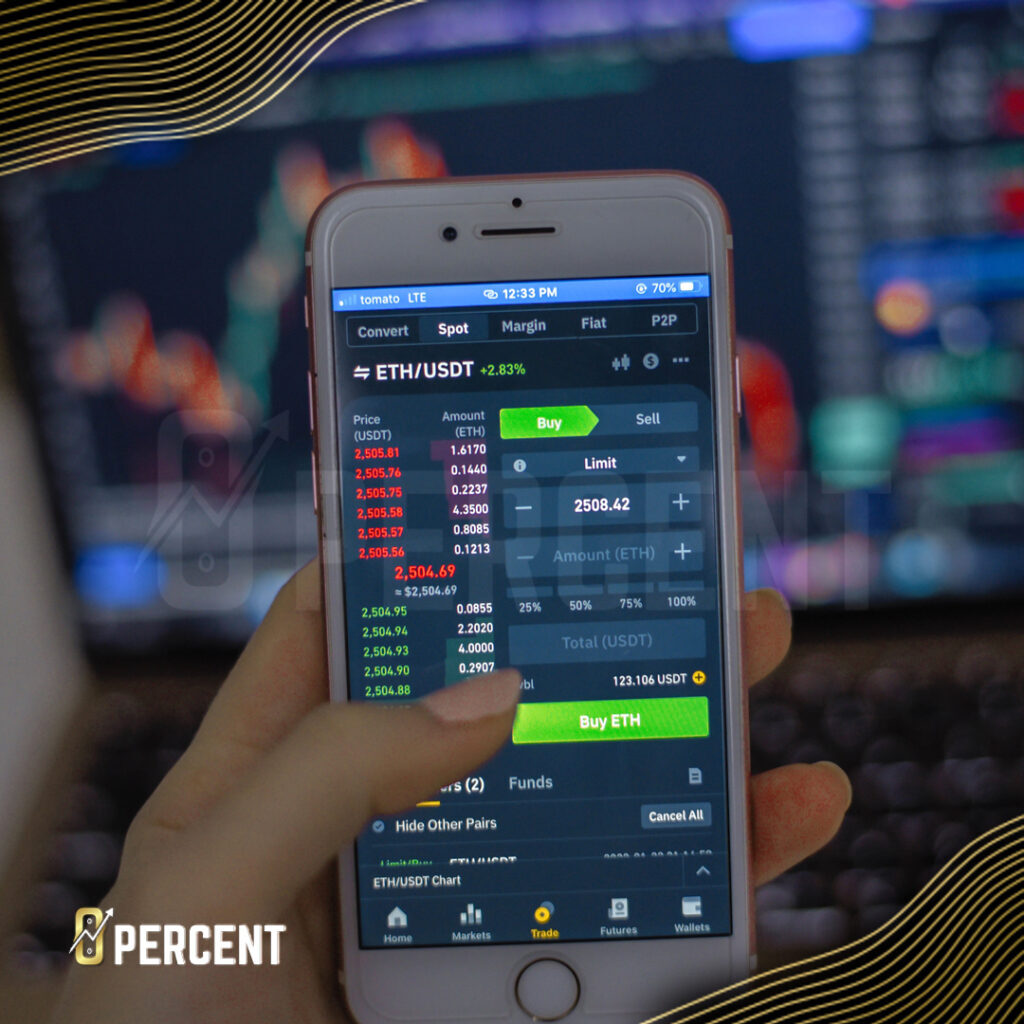
Jeff Sekinger
Jeff Sekinger Founder & CEO, 0 Percent Who is Jeff Sekinger? Visionary Trailblazer Sekinger has been in the financial industry for over a decade. Starting
Algorithmic trading refers to the use of sophisticated algorithms to trade on various financial markets. In recent years, algorithmic trading has become increasingly popular, and developments in that sector have advanced at a rapid pace, allowing for algorithmic trading bots to be an essential tool in the toolbox of financial investors.
Throughout the course of this guide, we will explore the various aspects of algorithmic trading, including its benefits, drawbacks as well as to get started on using algorithmic trading to potentially propel your investment strategy to new heights. It must be noted, however, that all investing carries risk, including investing using algorithmic trading bots. As a general rule, investors should never invest more than they can afford to lose, and should consult a qualified financial professional prior to conducting any trading or investing activity.

One of the primary benefits of algorithmic trading is that this technology allows traders and investors to execute trades faster than they would otherwise be able to. With the ever increasing pace at which our society is moving, and with the markets fluctuating faster and faster every day, time is of the essence, and having an algorithmic bot in your investing arsenal can prove to be an incredibly timely tool. Algorithmic trading systems can not only be trained to execute trades quickly, but can also be programmed to execute trades based on specific rules and conditions, for example when a certain price level is reached, or when a certain indicator crosses a predetermined threshold. This can help investors make disciplined trading decisions.
Another benefit to algorithmic trading is the potential reduction in human error. Humans are very smart creatures, but our capacity to retain and utilize information is limited. No single person is able to learn the entire market history of, for example, the forex market, but an algorithmic bot can be programmed with that knowledge, and that knowledge can be utilized and executed in real time to perform informed trades. Similarly, it may be difficult for any one person to learn every successful investing strategy, but algorithmic bots can be programmed with as many strategies as can fit on their hardware.
Human error stemming from emotion is another pitfall that we oftentimes succumb to when trading and investing. Our emotions can oftentimes get in our own way and can become an impediment to good decision making, leading to mistakes such as making impulsive trades, over-trading, or simply allowing our fear and greed to run amok. Algorithmic trading bots are programmed according to predetermined rules and functions, and can therefore execute trades in a more consistent and disciplined manner.
While algorithmic trading has a plethora of real and potential benefits, the technology carries with it several drawbacks. One of the main concerns is that algorithmic trading systems can be prone to technical issues. These technical issues can range from connectivity problems to software viruses, and even cybersecurity hacks. If not properly monitored and managed, algorithmic bots can do significant damage to one’s investment portfolio.
In addition, algorithmic trading systems can be expensive to set up and maintain, requiring significant time and resources to design, test and optimize.
First, it is imperative to conduct thorough research and understand the financial markets. This includes learning about various trading techniques and strategies, as well as risk management techniques. Traders should also develop an informed understanding of the various technicals and fundamentals underlying any informed trading decision.
Next, traders should choose a trading platform that offers algorithmic trading capabilities. There are numerous platforms available, each with their own set of pros and cons. Some of these platforms are simple and user friendly, while others are catered to the more experienced trader, with a wider range of advanced features and tools. It is also important to choose a platform that is both reliable, and offers adequate customer support, in case there is ever the need for it.
Upon having chosen the trading platform, traders can start designing and testing their algorithmic trading bots. This involves choosing the specific rules and conditions that your system will adhere to.
Finally — and this one is perhaps the most important step — traders should never rely exclusively on algorithmic trading bots to earn capital. This technology hasn’t yet been perfected, and should be utilized as a tool among other tools in your investing arsenal. Investors should continuously monitor their algorithmic trading bots.
As previously defined, algorithmic trading involves the use of sophisticated algorithms that aid an investor in buying and selling financial assets on various markets — gold, forex, the stock market, or even crypto. In recent years algo trading has become increasingly popular. The demand for this technology is only increasing, as the global financial sphere has become more intricate and complex.
Algo trading systems are programmed to follow predetermined rules and conditions that are built into the lines of code upon which the bots operate. For example, a trading bot might be programmed to buy or sell a certain financial asset when its price reaches a certain point. A well trained algorithmic trading bot will have rules and conditions that are based on sound technical and fundamental analysis, or on historically successful trading strategies. Once the algorithm has been programmed and turned on, no further human intervention is required, except to turn the system off, if necessary.
Because this technology is still emerging and evolving, it probably wouldn’t be wise to solely rely on algorithmic trading bots — at least not until further developments. Algo bots offer many benefits as a tool in an investor’s arsenal, but not as a standalone get rich quick protocol.
There are several benefits to using algorithmic trading:
There are also some drawbacks to algorithmic trading:
Like other investment activities, algorithmic trading bots carry risk as well as the potential to be profitable. Whether a trading bot is profitable will depend on a number of factors. As previously mentioned, it would be unwise to rely solely on any algorithmic trading system to manage your portfolio, though as a tool in the investor’s investing arsenal this technology may potentially offer several benefits. This technology isn’t perfect, and is being actively developed and upgraded every day. Having said that, algorithmic trading bots can be profitable. In fact, many algorithmic bots have been shown to significantly outperform human traders.
At the end of the day, a bot is simply an empty storehouse of data — how that bot is trained and used is what will differentiate between a successful and unsuccessful investment tool.
It is important to carefully design and test your algo bots to ensure that they are outperforming as expected, and to continuously monitor and optimize them. It is also important to remember that all trading carries some level of risk and that past performance is not necessarily indicative of future results.
There are many different algorithmic trading strategies that can be used, including:
These and any other successful (or unsuccessful) strategies can be programmed (trained) into the algorithm. This is why algorithmic bots can be profitable or not, depending on its algorithm.
Arbitrage is the strategy of taking advantage of price differences between different markets and exchanges. If the price of a particular stock is lower on one exchange than on another, a trader could buy the cheaper stock on one exchange and sell it where it is more expensive on the other exchange. Algo bots can be designed to execute this type of strategy and perform them at far faster speeds than a human trader — and without the trader having to actively monitor multiple markets and exchanges.
This type of strategy involves following the trend of a specific asset and buying or selling based on the direction of the trend. If a stock is trending upward, a trend based system trained algo bot might buy up the stock and hold it until the trend changes. Conversely, if the stock or asset is trending downward, the algo bot may sell the stock. Algorithmic trading bots can be designed with this strategy and execute trades with precision, and will not delay due to fear or greed. This will allow traders to capitalize on trends without having to actively monitor markets.
Trend based trading can be risky, and like all investment strategies programmed into trading bots, would require risk management strategies to be programmed alongside. Trends can change drastically and unexpectedly, and there is never any guarantee that any trend will continue in any given direction. Setting up risk management techniques, for example a stop-loss order, when using trend based trading would be wise.
Statistical arbitrage is a type of trading strategy that involves taking advantage of statistical discrepancies in prices between different securities. This can involve buying and selling the same security across multiple exchanges. This strategy also allows for the buying of a basket of securities that are expected to move in a certain direction based on statistical analyses. This strategy is complex and requires a significant amount of computing power and skills in data analysis, making this a great strategy to implement on your algo bots.
This strategy involves buying assets that are undervalued and selling assets that are overvalued as compared to their historical averages. If a stock has consistently traded at a certain price for a long period of time but has recently fallen below that price, an algo bot could buy that stock with the expectation that it will eventually return to or near its historical average. Mean reversion strategy can be used in a variety of financial markets.
This strategy involves executing trades at a specific price based on the average price of a security over a specific period of time. A weighted average price strategy may be designed to buy a stock at the average price it has traded at over the past week. Weighted average price strategies can be used to reduce the impact of stark market fluctuations and can be used to execute large trades in a consistent manner.
Weighted average price strategies can be useful strategies to be trained into an algo bot for traders who are looking to make faster and more accurate trades while reducing the risk for human error.
There are many algorithmic trading strategies that can be programmed into a trading bot, and it is important to carefully test your bots to ensure that they are operating as expected. It is also important to remember that all trading carries some level of risk, and while algorithmic bots can oftentimes reduce some risk, they cannot eliminate it entirely.
Algorithmic trading can potentially benefit the average investor in several ways:
Because algorithmic trading bots use computerized algorithms, this technology can save the investor countless hours in research, as well as in learning investment strategies. The machine learning involved can quickly and accurately analyze massive amounts of meta data and execute trades based on that data in real time, allowing the investor to focus less on trading and more on other tasks.
In a world of fast moving markets, where time is of the essence and where human emotions can lead to impulsive or poorly-informed trading decisions, it is more important than ever to be able to make accurate trades while minimizing the risk of error. Algo bots can help to achieve that.
Algorithmic systems are not influenced by emotions, which oftentimes act as an impediment to human trading. This can lead to more disciplined and informed trading decisions, and can be particularly beneficial for investors who may struggle to control their emotions when trading.
Algo bots can be tested, programmed and optimized using historical data. This is known as backtesting and can help to identify potential issues or weaknesses in a strategy before it is put into use. Through backtesting an algorithmic trading bot, users can gain a deeper understanding of how it is likely to perform under different market conditions, and can show opportunities to make adjustments as needed.
While many algorithmic trading bots are expensive, many are not and the technology can be a convenient and cost-effective way for individuals to manage their investments, especially for those who may not have the time or expertise to manage their own portfolio.
Though algorithmic trading bots are not technically the same thing as artificial intelligence, AI and machine learning are already being integrated into fintech and this trend is not likely to stop any time soon. Through the use of machine learning and AI, trading bots may in the future become more and more advanced and better equipped to effectively and profitably trade on multiple markets and exchanges. While the integration of AI in fintech can potentially solve many longstanding problems and challenges, it will inevitably bring with it a new set of challenges and unintended consequences.
Algorithmic trading bots can be a powerful tool for both advanced and novice investors. While there are many different types of algorithmic trading bots, it is important not to rely too much on this technology, but rather to work with it and use this technology as a tool.

Jeff Sekinger Founder & CEO, 0 Percent Who is Jeff Sekinger? Visionary Trailblazer Sekinger has been in the financial industry for over a decade. Starting

Angel Alvarez Funding, 0 Percent Who is Angel Alvarez? From SpaceX to 0 Percent Angel is a remarkably well rounded individual who has had a

Abhay AnandProduct, 0 Percent Who is Abhay Anand? Title One Test Title Two Test Test
Sign up for our newsletter to stay in the loop.
Sign up to receive news & updates!
Sign up to receive news & updates!